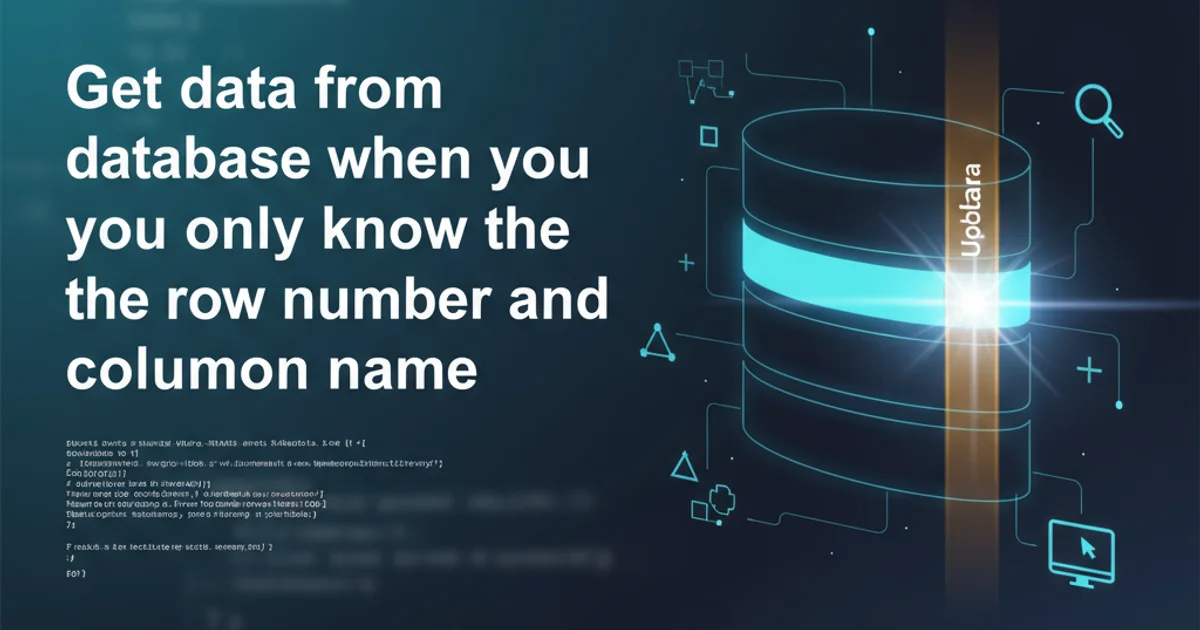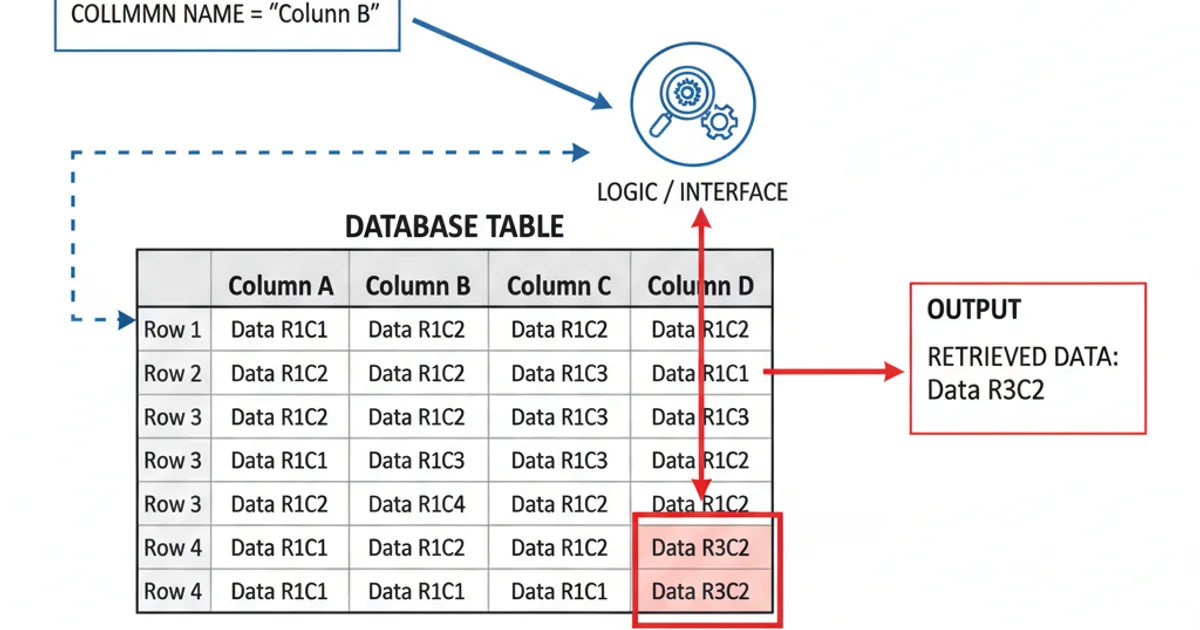Get data from database when u onlw know the row number and column name
Categories:
Accessing Database Data by Row Number and Column Name

Learn how to retrieve specific data from a database when you only know the row number and column name, exploring various SQL and programming language approaches.
Retrieving data from a database typically involves querying based on primary keys, unique identifiers, or specific conditions. However, there are scenarios where you might need to fetch data using less conventional methods, such as a row's ordinal position (row number) and a column's name. This can be particularly challenging as standard SQL doesn't directly support row-number-based access in the same way it handles primary keys. This article will guide you through different techniques to achieve this, covering various database systems and programming languages.
Understanding the Challenge
Databases are designed for set-based operations, not positional access. A 'row number' is not an inherent property of a row in a relational database table unless explicitly assigned or generated during a query. The order of rows in a table is not guaranteed without an ORDER BY clause. Therefore, simply asking for 'the 5th row' is ambiguous without defining what constitutes the '5th row' (e.g., 5th by ID, 5th by creation date, etc.). Similarly, while column names are straightforward, combining them with a dynamic row number requires careful query construction.
flowchart TD
A[Start Query] --> B{Define Row Order?}
B -->|No| C[Ambiguous Row Number]
B -->|Yes| D[Use ORDER BY Clause]
D --> E[Assign Row Number (ROW_NUMBER() / ROWNUM)]
E --> F[Filter by Row Number]
F --> G[Select Specific Column]
G --> H[Return Data]
C --> I[Cannot Reliably Get Data]Flowchart illustrating the process of retrieving data by row number and column name.
SQL Techniques for Row Number Access
To access data by row number, you first need to assign a stable, sequential number to each row based on a defined order. This is typically done using window functions like ROW_NUMBER() or database-specific pseudo-columns like ROWNUM (Oracle) or LIMIT/OFFSET (MySQL/PostgreSQL).
ORDER BY clause when using ROW_NUMBER() or similar functions to ensure a consistent and predictable row numbering. Without it, the row numbers might vary between executions.SQL Server / PostgreSQL
SELECT column_name
FROM (
SELECT
column_name,
ROW_NUMBER() OVER (ORDER BY primary_key_column) AS rn
FROM your_table
) AS subquery
WHERE rn = @row_number;
Oracle
SELECT column_name
FROM (
SELECT
column_name,
ROWNUM AS rn
FROM (
SELECT column_name FROM your_table ORDER BY primary_key_column
)
) WHERE rn = :row_number;
MySQL
SELECT column_name
FROM your_table
ORDER BY primary_key_column
LIMIT 1 OFFSET (@row_number - 1);
Accessing Data in Application Code
Once you have the SQL query to retrieve the specific row, you can execute it from your application code. The challenge then becomes dynamically selecting the column by its name from the result set. Most database connectors provide methods to access data by column name.
Python (psycopg2 for PostgreSQL)
import psycopg2
def get_data_by_row_col(conn, table_name, column_name, row_number, order_by_col):
try:
with conn.cursor() as cur:
query = f"""
SELECT {column_name}
FROM (
SELECT
{column_name},
ROW_NUMBER() OVER (ORDER BY {order_by_col}) AS rn
FROM {table_name}
) AS subquery
WHERE rn = %s;
"""
cur.execute(query, (row_number,))
result = cur.fetchone()
return result[0] if result else None
except psycopg2.Error as e:
print(f"Database error: {e}")
return None
# Example usage (assuming 'conn' is an active connection)
# data = get_data_by_row_col(conn, 'products', 'product_name', 5, 'product_id')
# print(data)
Java (JDBC)
import java.sql.*;
public class DbAccessor {
public String getDataByRowCol(Connection conn, String tableName, String columnName, int rowNumber, String orderByCol) {
String sql = String.format(
"SELECT %s FROM (SELECT %s, ROW_NUMBER() OVER (ORDER BY %s) AS rn FROM %s) AS subquery WHERE rn = ?;",
columnName, columnName, orderByCol, tableName
);
try (PreparedStatement pstmt = conn.prepareStatement(sql)) {
pstmt.setInt(1, rowNumber);
ResultSet rs = pstmt.executeQuery();
if (rs.next()) {
return rs.getString(columnName);
}
} catch (SQLException e) {
e.printStackTrace();
}
return null;
}
// Example usage (assuming 'conn' is an active connection)
// String data = new DbAccessor().getDataByRowCol(conn, "users", "username", 3, "user_id");
// System.out.println(data);
}
row_number. For column and table names, ensure they are validated against a whitelist or are trusted inputs, as they cannot typically be parameterized.Considerations and Best Practices
While these methods allow you to retrieve data by row number and column name, it's important to consider the implications:
- Performance: Queries involving
ROW_NUMBER()orLIMIT/OFFSETwith large offsets can be less performant than direct primary key lookups, especially without proper indexing on theORDER BYcolumn. - Data Integrity: Relying on row numbers can be fragile. If rows are inserted, deleted, or the
ORDER BYcriteria changes, the 'Nth' row might refer to different data. - Alternative Approaches: Before resorting to row number access, evaluate if there's a more robust way to identify the specific data point you need, such as adding a unique identifier or using more specific filtering conditions.
- Dynamic Column Selection: If the column name is also dynamic, ensure your application layer handles this gracefully, potentially by fetching the entire row and then extracting the desired column by name.

Conceptual view of accessing a specific data point using row number and column name.